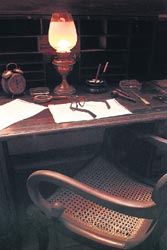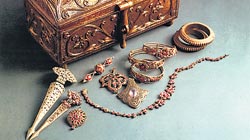
Revisiting a writer, a village and its cultureFrom the Cradle- Glimpses of Sri Lankan Folk Culture portrayed at the Martin Wickramasinghe Museum of Folk Culture. Text by D.C. Ranatunga. Photographs by Sarath Perera. Design and layout by Somachandra Peiris. Published by the Martin Wickramasinghe Trust. Price: Rs 2,800. None of the three who have played a major part in the production of this elegant volume would claim individual credit for their efforts. They have worked as a team and it is this felicitous blend of readable text, excellent photographs and professional design that gives this volume launched on May 29, Martin Wickramasinghe’s birth anniversary, its classy feel.
Martin Wickramasinghe’s hometown of Koggala always retained a special place in his heart, as his descriptions of it written much later amply illustrate. ‘From the Cradle’ is not an autobiographical tome, rather a celebration of the folk culture that was intrinsic to this rural hinterland with its contents not focusing solely on the Great Man himself but on the Museum of Folk Culture that now occupies Wickramasinghe’s birthplace.
Pictures that so beautifully capture the mood of this tranquil place and its many artifacts are accompanied by descriptive and informative text that seeks to take the reader back to the typical middle class Southern home of the early 19th Century. The book is liberally laced with MW’s writings and these indeed add spice to the presentation, transporting the reader back in time to the home and its lifestyle as seen through MW’s sharp writer’s eye. Accompanying the picture of the room where he was born is his pithy account taken from Upanda Sita- From the Beginning, written in 1961: “I have heard it being repeated several times by my relations that when the midwife emerged from the closed room to announce the arrival of a sarong, my father as well as my sisters and cousins were thrilled. They were jubilant that after eight kambas, I was the only sarong that mother had produced.” (A footnote explains that Wickramasinghe was the only boy among eight sisters, the reference to sarong and kamba also explained.Different chapters describe the way of life that characterized Koggala. ‘Learning the first letters’ is illustrated with pictures depicting how writing was first done on trays of sand (veli pila) and then on ola with a stylus.
The reader is enlightened as to the process of how the talipot leaf is prepared and then made into a book. Other chapters are equally descriptive, with pictures of the artifacts at the Museum of Folk Culture cleverly interspersed with others taken to illustrate the themes such as Home Kitchen, Festival Time, The thrills on the water which looks at the traditional southern occupation of fishing etc. A chapter on the skilled craftsmen of the South adds much to the book, taking the reader through the carpentry shed, to the village forge and then touching on the genius of the mask makers, the drums and the puppets, that were a staple of village entertainment. Lace-making, introduced to the country as a cottage industry by the Portuguese, and the art of embroidery, to cater to local tastes with traditional designs, both very important pastimes associated with the South are included. “The Sinhala word beeralu is derived from the Portuguese word bilrof or biralureinda” we are told. The book ends with a master touch that surely Martin Wickramasinghe would have approved of : two scholarly yet marvellously readable articles on the Great Man by Tissa Abeysekera and Prof. K.N.O. Dharmadasa. These enhance the reader’s understanding of Martin Wickramasinghe, the first looking at his roots in Koggala “the womb and cradle of his genius” and the other at his literary legacy. Foreign and local visitors to the museum will find this book an ideal keepsake of their visit to the Folk Museum but it is more-a delightful entre into the world of one of the country’s greatest sons. |
|| Front
Page | News | Editorial | Columns | Sports | Plus | Financial
Times | International | Mirror | TV
Times | Funday
Times || |
| |
Copyright
2007 Wijeya
Newspapers Ltd.Colombo. Sri Lanka. |


